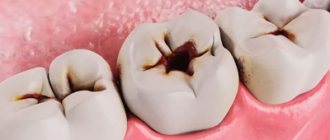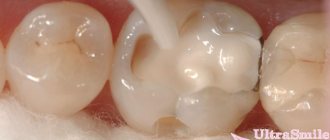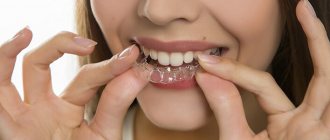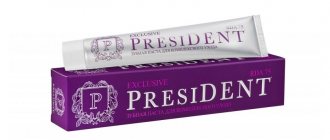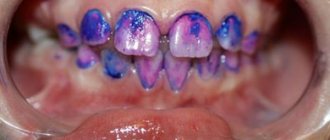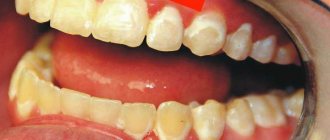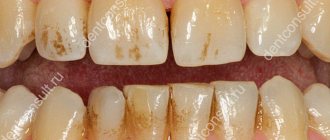The article describes what teeth whitening is, explains how it is carried out using chemicals and pharmaceuticals, and indicates contraindications to this procedure.
Everyone associates a snow-white smile with Hollywood actors who are as brilliant as their teeth. White, healthy teeth not only attract the opposite sex, but also add self-confidence. Bad teeth instantly spoil the appearance of a person and can be both a source of pride and a source of embarrassment.
Modern means offer many products for teeth whitening. Miracle-effect toothpastes, magic gels, teeth whitening kits and even chewing gum. After all, dental clinics in Moscow carry out this very dream procedure for a snow-white smile, if you dare to visit a doctor.
Is it really that simple, safe and painless?
Are white teeth healthy teeth?
This is not to say that healthy teeth must be the color of the first snow. The color of teeth directly depends on a person’s genetics, hereditary factors, lifestyle and nutrition. Some factors are historically formed for a particular region. It's nothing you can do. Therefore, even yellowish teeth can be much healthier than white ones.
Every day a person consumes coffee, tea, and foods containing food dyes, which cannot but affect the color of the teeth. Just like smoking.
Is it possible to whiten teeth using hygiene procedures?
Even repeated daily brushing of teeth, with all its regularity and thoroughness, cannot significantly affect the color of teeth. Of course, this gives its results, but there is no need to talk about whitening a tone or two. Miracle toothpaste can't beat genetics.
Twice a year, a person needs to undergo professional teeth cleaning to remove tartar and other deposits from a dentist, but this is not a panacea. Although this is very, very important for dental health. Prevention is always better than cure.
Dental treatment is painful. We destroy myths.
Since childhood, dental treatment has been associated with pain. And even at a more mature age, the thought will certainly itch in the background: what if it hurts? Or will the anesthesia not work?
Pavel Anatolyevich Pazhlakov, a dentist at the Dudko and Sons Dental Implant Center,
answered questions about the possibilities of pain relief in modern dentistry - Pavel Anatolyevich, could you outline what options for pain relief exist in modern dentistry? All methods are divided into local, general anesthesia and their combinations. Local means that it acts only on the area that actually needs to be anesthetized, that is, in our case, on the nerves that directly transmit the pain signal from the tooth. With general anesthesia (or anesthesia), a person falls asleep and does not feel anything. In dentistry, this option is in the vast majority of cases redundant. We always try to adhere to the golden rule: pain relief must be adequate and reasonable - that is, correspond to the specific clinical situation. In each case, you need to choose the most effective and, at the same time, safe method of pain relief. — How can you “turn off” the nerve that transmits the pain signal from the tooth?
For this purpose, local anesthetics are used, what is popularly called “freezing”. These substances block the transmission of signals along the nerve. How to deliver the anesthetic to the nerve? The two most popular options are the so-called infiltration and conduction anesthesia. In the first case, we simply inject the anesthetic into the tissue using a syringe - naturally, it reaches the peripheral nerve endings and blocks them. In the second, we inject the drug in the immediate vicinity of the nerve in the place where all the fibers conducting the signal from the desired area have already gathered into a single bundle. In any case, all the paths through which a message about pain can reach the brain are blocked - and the person does not feel anything. - But the injection itself is not very pleasant either. Some people are afraid of the injections themselves. For this case, there is topical anesthesia. Its essence is that an anesthetic, gel or spray, is applied to the area that needs to be numbed before anesthesia is administered with a syringe. Application anesthesia is not very effective in the sense that it only anesthetizes the superficial layers. But it allows you to “turn off” an area of skin so that the patient does not feel the injection. — Do local anesthesia have side effects? Some people are intolerant to local anesthetics. You may remember that when you go to the dentist, he always asks: “Have you had pain relief before?” This is done to see if the person has had a reaction to the local anesthesia. — If there was such a reaction, what to do? Treat teeth under anesthesia?
No, why so radical right away? Just use a different anesthetic; there are a lot of them available now. Sometimes, however, there are patients who cannot tolerate any local anesthetics at all - then yes, anesthesia or sedation. — It turns out that any patient can be given adequate pain relief? And is there a difference in pain relief for the upper and lower jaws? Yes. There are, of course, difficult cases, but the arsenal of methods is so wide that there is always something suitable. And if we consider the analgesic effect, then a 100% anesthetic effect is not always observed on the lower jaw because bone tissue is more dense. Because of this, it is less permeable to the anesthetic solution. In such cases, we increase the waiting time for the onset of anesthetic pain relief or increase the dose of the drug. - Thank you, Pavel Anatolyevich, after talking with you, it’s almost no longer scary to go to get your teeth treated. But I still really don’t want them to be drilled... And don’t! My advice to patients is to contact dentists before anything starts to hurt. You should try to go for a preventive examination at least twice a year in order to prevent complications that can cause a lot of problems. There is no need to be afraid to go to the dentist, he is not an inquisitor: if you are healthy, no one will try to make extra “holes” in your teeth. And if your teeth need to be treated, today it can be done absolutely painlessly. In order to visit a dentist , you need to: make an appointment by calling +375445450910 or go to the consultation page.
Fear of dentists - first person:
The article was prepared by a specialist: Pavel Anatolyevich Pazhlakov
Teeth whitening
Effective whitening can only be carried out using chemicals, special lamps and lasers. This can be done in two ways: at the dentist and at home. The dentist may treat the teeth with a special chemical or use a laser and light. The second method is more expensive, but gives a longer and more reliable result. For full results, up to three procedures are required. Then the effect must be maintained at home using improvised means. So, you need to purchase a special medical mouthguard and a bleaching agent, which the doctor will recommend. The mouth guard with the substance is worn at night. It is recommended to make a mouth guard that exactly follows the shape of the jaw. The first such procedure lasts 5–10 nights, then it must be repeated every six months to maintain color.
After a series of such events, the result is usually quite high quality and long lasting.
Teeth whitening is by no means the removal of a layer of enamel. This is a process similar to lightening hair using chemicals.
Possible problems
Tooth sensitivity:
During the first 24 hours after in-office whitening, some patients experience increased tooth sensitivity. Sensitivity is usually minor, except in cases of pre-existing tooth sensitivity. With clinical bleaching, this unpleasant symptom usually goes away within 1-2 days.
If your teeth are initially sensitive, whitening may improve this sensitivity for a longer period of time. In such cases, you may decide to postpone whitening until your doctor performs desensitization procedures. If your teeth become sensitive after whitening, you can take analgesics such as paracetamol until your normal sensitivity is restored.
With all the advantages of Zoom, it can be used if you have cured caries and other diseases of the teeth or gums. In this regard, it is no different from other whitening technologies.
Whitening degree:
It is impossible to reliably predict what color your teeth will be after whitening. With in-office whitening, your teeth can be significantly whitened in one or two visits. With home whitening, within 2-4 weeks of daily use of trays and the prescribed number of hours, you will significantly whiten your teeth. We do not recommend at-home whitening for longer than four weeks.
Gradual darkening of tooth tissues and weakening of the new shade of teeth
may appear after the whitening procedure is completed. No system can guarantee you lasting results for life. To prevent this, you may need to periodically maintain your whitening results by using at-home whitening systems with trays.
PhilipsZOOM
uses a light source that emits ultraviolet light in the UVA range. Although the lamp output is less than half the UVA rays used in conventional tanning salons, protection and precautions are taken during this procedure. It must be remembered that patients undergoing photo-, chemo- and PUVA therapy, as well as patients with melanomas, must consult with a therapist before undergoing the whitening procedure.
Pharmacy products for teeth whitening
Advertising is replete with miraculous pastes, gels and chewing gums for instant teeth whitening. In truth, miracle chewing gum is nothing more than just a publicity stunt. As for toothpaste and gels, you should not use them constantly, as this will lead to increased tooth sensitivity and will negatively affect the quality of tooth enamel. Gels and pastes do not provide a long-lasting effect. Only a dentist can perform the procedure efficiently and professionally.
Side effects
Among the side effects of whitening, the first place belongs to increased sensitivity of teeth. Pain when eating hot, cold, sour or sweet foods. If such a problem occurs, the doctor will prescribe the necessary remedy. Also, the impression of the procedure is spoiled by the too obvious result - teeth of an unnatural ceramic shade and shine.
Contraindications
After professional teeth whitening, the patient should not consume products containing dyes. Dyes that are too bright may remain on the teeth. The same applies to drinking coffee, tea and smoking. The bright pigment can penetrate the surface of the tooth and ruin your new smile. Whitening cannot be performed if the patient is pregnant or breastfeeding. Also, whitening is not recommended for those who have a lot of caries on their teeth. If there are a lot of fillings on the front teeth, whitening will bring a great contrast between the color of the fillings and the actual color of the teeth. The person will need re-prosthetics. Whitening is not recommended for people under 18 years of age.
So, teeth whitening is one of the benefits of civilization and new technologies. This procedure requires care in preparation and careful care to maintain the beauty of the result and the radiant shine of a snow-white smile after whitening. You should always remember that white teeth do not always mean their health.
Zoom technology
Previously, whitening systems were not perfect: they created an acidic environment and high temperature in the teeth, which harmed them.
Now you don’t have to choose between beauty and safety, since these factors have been eliminated. There are several types of whitening in dentistry:
- - homemade
- — intracanal bleaching
- - office (cabinet)
At-home whitening includes whitening with strips or whitening with trays. The strips are glued to the teeth according to the pattern proposed by the manufacturer. They are commercially available and this obliges the manufacturer to use a safe concentration of the bleaching solution (hydrogen peroxide) so that it can even be swallowed.
Consequently, the gel concentration is very low and whitening is ineffective. The strips create an acidic environment on the teeth, which microorganisms in the oral cavity “like” very much, and this is already dangerous for dental health. The strips only work on the surface and often only whiten plaque. Moreover, the plaque becomes porous and subsequently absorbs dyes and the teeth become even darker.
When a patient uses mouth guards, there are also two ways: standard or individual mouth guards.
Standard aligners contain a bleaching agent, are sealed and are disposable. Custom mouth guards are made in the dentist's chair, requiring the patient to sit in the chair for just five minutes, and the doctor will mold them from a thin sheet of transparent plastic. They are reusable. The patient precisely applies the whitening gel into these trays according to the manufacturer’s instructions.
Here, whitening is divided into daytime and nighttime, while they use different concentrations of the gel and, accordingly, different exposure times on the teeth (twice a day for 30-60 minutes or all night). The whitening course lasts about two to three weeks. Moreover, the effect lasts quite a long time.
The advantage of home whitening is that it is easier to use and less expensive. The disadvantage is the inconvenience of wearing whitening trays, and the fact that the result depends on your patience and regularity of using the trays. If sensitivity occurs while using at-home whitening, you may need to reduce the number of hours you wear the trays or stop using them for a short time until the sensitivity subsides.
If there is mechanical trauma or root canal filling after nerve removal, darkening of the tooth may occur. Here, intra-canal bleaching is used using a special gel, which the doctor places inside the tooth and covers with a temporary filling. Such manipulations are repeated from two to five times. Then a permanent restoration is installed.>
The principle of in-office whitening is that all procedures are performed on the patient in the dentist's chair. This usually takes one and a half to two hours. When whitening, a special gel is applied to the patient’s teeth, it is exposed to an ultraviolet lamp and, under its influence, active oxygen is formed, which draws out the dark pigment.
Photobleaching using Zoom systems began to be carried out in Russia only a few years ago. The advantages of Zoom were immediately obvious: no mechanical impact, whitening by 8-12 tones at once, and the effect lasted longer than with other types of whitening.
In Zoom 1-2, the hydrogen peroxide content could not be lowered below 35%. The gel used for “Zoom 3” contains only a 25 percent concentration of hydrogen peroxide, which does not damage the enamel.
The fact is that the 35 percent solution formed many micropores in the enamel so that active oxygen could reach the deep layers of the tooth. These micropores did not disappear for a long time, and the patient had to suffer from tooth sensitivity for 2-3 weeks in a row.
A 25 percent peroxide content is completely harmless. The enamel is quickly restored, and you no longer have to pay for a snow-white smile with painful sensations. The gentle effect is increased by adding amorphous calcium phosphate to the gel, which strengthens the enamel during whitening.
PHILIPS has the exclusive right to use amorphous calcium phosphate in all bleaching systems.
Amorphous calcium phosphate, easily dissolving in saliva, promotes the rapid formation of various apatite crystals located in enamel prisms.
As a result, small defects and scratches are filled with amorphous calcium phosphate and, as a result of hydrolysis, are immediately converted into apatites, giving the tooth a smooth surface and a healthy shine. Also, as a result of this, sensitivity is reduced, the possibility of teeth darkening due to food dyes is reduced, and the whitening effect is significantly prolonged. The addition of amorphous calcium phosphate is patented by the American Dental Association (ADA).
The license for the use of calcium phosphate with whitening systems is exclusively issued to Philips ZOOM, the world leader in the production of whitening systems. Since concentrated whitening gel is used for the whitening procedure, it is necessary to protect the soft tissue.
When using Zoom whitening systems, the lips are covered with plastic protection, the cheeks are isolated with special gauze and the gums are covered with liquid rubber dam - this is a gel that is applied to the gums and illuminated with a lamp, the same one that the dentist uses to shine the filling. This protection helps prevent chemical burns of the gums and negative effects on the mucous membranes.
Whitening methods
You can whiten your teeth yourself at home. But it is simply impossible to guarantee that such a procedure will be safe and painless.
It is better to entrust teeth whitening to a dental clinic; dentists offer the following methods:
- Using a special whitening tray . The mouthguard is put on the teeth and a special solution begins to act on the surface of the teeth. You need to use such mouthguards for several weeks, 2-3 hours a day.
- Laser whitening is one of the gentle methods that does not cause pain or discomfort. One laser whitening procedure allows you to make your teeth 5 – 6 shades brighter. To protect the gums from exposure to light, they are treated with a special gel. The procedure takes about 45 minutes.
- In-canal bleaching . This method is used if, after treatment of the tooth, the pulp has darkened. The darkened canal is expanded and cleaned, a special gel is placed inside and first a temporary, and after a week a permanent filling. This technique is used extremely rarely and is performed under anesthesia.
- Teeth whitening using lamp light . This is another modern whitening method, which is carried out using a special gel and equipment. The surface of the tooth is covered with gel, which after some time penetrates under the enamel. This gel, already under the enamel, is exposed to lamp light and the color of the teeth gradually changes. The great advantage of this method is the absence of pain and discomfort, as well as the ability to carry out this procedure within 40 minutes.
Are preparatory procedures necessary before lightening tooth enamel?
The process of preparing for teeth whitening takes place in several stages:
- examination of the dentist and identification of absolute and relative contraindications;
- sanitation of the oral cavity and installation of temporary fillings, if necessary;
- removal of tartar, plaque, polishing and fluoridation.
A few weeks before the procedure, it is advisable to start a course of medications to reduce sensitivity and strengthen the enamel. The doctor will recommend special gels and pastes for treating teeth.
At the patient’s request, the dentist will take impressions to make a special mouth guard for subsequent use at home. This will help prolong the effect of the professional procedure.
Carry out the whitening procedure at the Clarimed clinic, we guarantee excellent results

